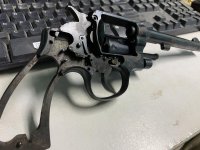Luckylineman1970
Member
- Joined
- Feb 27, 2022
- Messages
- 13
- Reaction score
- 5
Hello all & thanks for having me as a new user
I have a 32-20 hand ejector that I found in my dads machine shop, disassembled and with patches of pitting.
I am looking a source for a good drawing of the pistol as it seems to be missing a few internals most notably the mainspring & crane retaining ring.
Serial# appears to be 132665 help with approximate dating would be greatly appreciated.
The bore is good and I would like to make it back shootable then parkerize it or ceracoat or something similar to make a backpacking gun.
Any thoughts, ideas or advice from S&W experts such as yourselves would be listened to carefully
I'm no stranger to firearms & working on my own I'm just not very experienced with S&W revolvers
Many thanks in advance
I'll post a few pictures in a few
I have a 32-20 hand ejector that I found in my dads machine shop, disassembled and with patches of pitting.
I am looking a source for a good drawing of the pistol as it seems to be missing a few internals most notably the mainspring & crane retaining ring.
Serial# appears to be 132665 help with approximate dating would be greatly appreciated.
The bore is good and I would like to make it back shootable then parkerize it or ceracoat or something similar to make a backpacking gun.
Any thoughts, ideas or advice from S&W experts such as yourselves would be listened to carefully
I'm no stranger to firearms & working on my own I'm just not very experienced with S&W revolvers
Many thanks in advance
I'll post a few pictures in a few


